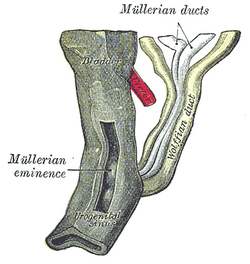
Back Wolffbuis Afrikaans قناة الكلوة الجنينية الموسطة Arabic উলফিয়ান বাহিকা Bengali/Bangla Mezonefrički kanal BS Wolffův vývod Czech Urnierengang German Conducto de Wolff Spanish Esmasneerutoruke Estonian Wolffen hodi Basque Canal de Wolff French
| Mesonephric duct | |
|---|---|
 Urogenital sinus of female human embryo of eight and a half to nine weeks old | |
| Details | |
| Carnegie stage | 11 |
| Days | 28 |
| Precursor | Intermediate mesoderm |
| Gives rise to | Vasa deferentia, seminal vesicles, epididymides, Gartner's duct |
| Identifiers | |
| Latin | ductus mesonephricus; ductus Wolffi |
| MeSH | D014928 |
| TE | duct_by_E5.6.2.0.0.0.4 E5.6.2.0.0.0.4 |
| Anatomical terminology | |
The mesonephric duct, also known as the Wolffian duct, archinephric duct, Leydig's duct or nephric duct, is a paired organ that develops in the early stages of embryonic development in humans and other mammals. It is an important structure that plays a critical role in the formation of male reproductive organs. The duct is named after Caspar Friedrich Wolff, a German physiologist and embryologist who first described it in 1759.[1]
During embryonic development, the mesonephric ducts form as a part of the urogenital system.[2]
- ^ synd/2845 at Who Named It?
- ^ Du, Hongling; Taylor, Hugh S. (January 1, 2015). "Chapter 27 - Development of the Genital System". In Moody, Sally A. (ed.). Principles of Developmental Genetics (Second ed.). Academic Press. pp. 487–504. doi:10.1016/b978-0-12-405945-0.00027-2. ISBN 9780124059450 – via ScienceDirect.
© MMXXIII Rich X Search. We shall prevail. All rights reserved. Rich X Search